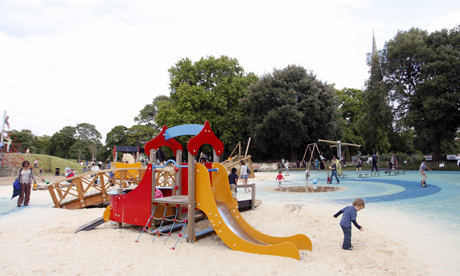Olympic torch route, day 64: there’s something for everyone in Clissold Park

Children's play area, Clissold Park. Photograph: Hackney Council
The torch is on the home straight now. From Clissold Park, where the torch passes on Saturday, it is only four miles as the crow flies from the Olympic Village. Until now the Olympics has been an abstract in London life: omnipresent, in the blur of tube posters and the endless stream of schoolchildren trailing egg-carton-and-Frostie-packet stadiums out of the school gates, but still intangible. By Saturday evening, when it reaches Hackney Marshes, the torch will be within sight of the velodrome; before that it passes through Shoreditch, Hoxton, Dalston, and Clissold Park in Stoke Newington.
I have lived near Clissold Park almost my whole life. I splashed and shrieked in the paddling pool until my teeth chattered when I was tiny; as a teenager I climbed trees to smoke illicit cigarettes and talk about boys. The very first time I left the house with my first baby, it was for a walk around the Clissold Park ponds.
The park has been transformed during this time. From being rundown and dowdy, with algae in the New River and teardrops of grease in the cups of tea, it has come into a Lottery windfall and been spruced into an urban planner’s fantasy vision of communal space, all landscaped imaginative play and salted-caramel ice cream.
But gentrification is not the point; not at all. In the early 1990s, when it was scarred by burned out benches and graffiti, Clissold Park was still beautiful. The candles on the horse chestnut trees – especially the huge pink one, that stands in the centre of the southwestern lawn – are just as glorious, come late April, in the bad times as in the good. When blanketed under a lawn of white snow, or heady in the glow of a heatwave, the park has always been magical.
The park has been through dramatic swings of fortune; in the late 19th century it was snatched from the jaws of developers to become a public space. An ancestor of Virginia Woolf inhabited Clissold House, now the park cafe, when it was a private home. After visiting the park in 1937, she wrote in her diary of the contrast between the life her family would have led there when the house was an elegant private home in which “Grandpapa studied The Times while [his wife] cut roses”, with the noise and bustle of 1930s “Clissold Park mothers; & cakes & tea; the smell – unpleasant to the nose – of democracy”. Her use of mothers, cakes and tea as an image to conjure bad smells and undesirables jars now, in an age where the yummy mummy is derided as a figure too frivolous for our age of austerity.
How times change. And yet, some things don’t, and one constant is the way in which green spaces are at the heart of urban life. This sounds like a contradiction, but it’s not, because urban life is all about embracing contrast, about accepting light and shade as the right and proper way of the world. Woolf also wrote about life in London that in the “street outside, one catches a word in passing and from a chance phrase fabricates a lifetime”. From these overheard conversations, she suggested, it was possible to “penetrate a little way, far enough to give oneself the illusion that one is not tethered to a single mind, but can put on briefly for a few minutes the bodies and minds of others”.
She was writing about London, but the same is true of city life anywhere, of course. On the street or the tube these other lives rush by in a hurry, but in the park they linger cheek by jowl with yours. You see someone else’s child do their first wobbly, triumphant bike ride and you share beaming smiles with their proud dad; you share a park bench with strangers, absentmindedly eavesdropping as you finish your sandwich. The boundary between public and private blurs, just a little.
Fortunes rise and fall, and each era leaves its mark. People say that the stately giant terrapins which live in the ponds are the result of the long-gone Ninja Turtle playground craze. Cute, inch-long terrapins were briefly popular as pets; when the creatures outgrew their tanks, parents smuggled them to the park and tipped them into the river, where they grew to the size of footballs and can be seen sunbathing on warm days. Virginia Woolf, skater kids, Bugaboo mums and Ninja Turtles: there’s something for everyone in this park.
Jess Cartner-Morley is the Guardian’s head of fashion
guardian.co.uk © Guardian News & Media Limited 2010
Published via the Guardian News Feed plugin for WordPress.
